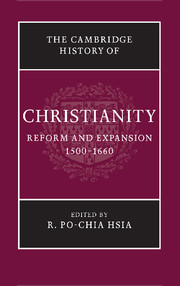Book contents
- Frontmatter
- Part I Luther and the Holy Roman Empire
- 1 Martin Luther, Reformer
- 2 Emergence and consolidation of Protestantism in the Holy Roman Empire to 1600
- 3 The Radical Reformation
- 4 Lutheranism in the Seventeenth Century
- Part II The Second Reformation
- Part III Catholic Renewal
- Part IV Resolving Confessional Conflicts
- Part V Religion, Society, and Culture
- Part VI Christianity and Other Faiths
- Bibliography
- Index
- References
4 - Lutheranism in the Seventeenth Century
from Part I - Luther and the Holy Roman Empire
Published online by Cambridge University Press: 28 March 2008
- Frontmatter
- Part I Luther and the Holy Roman Empire
- 1 Martin Luther, Reformer
- 2 Emergence and consolidation of Protestantism in the Holy Roman Empire to 1600
- 3 The Radical Reformation
- 4 Lutheranism in the Seventeenth Century
- Part II The Second Reformation
- Part III Catholic Renewal
- Part IV Resolving Confessional Conflicts
- Part V Religion, Society, and Culture
- Part VI Christianity and Other Faiths
- Bibliography
- Index
- References
Summary
Luther’s legacy contested
When Martin Luther died unexpectedly in 1546, Philip Melanchthon was his obvious heir. But as we know from bitter disputes among Lutherans that erupted almost immediately after Luther’s death and which lasted for several decades, Melanchthon’s authority was never accepted by all of Luther’s disciples. Indeed, it seems only a minority considered him to be Luther’s true successor. How can this be explained? First, in all of his writings Luther produced no systematic summary of his theology. He addressed specific problems, discussing at great length controversial issues which were brought to his attention, and spelled out in his answers many specific positions which served to characterize his theological approach. But he never wrote a large treatise explaining dogmatic matters in a comprehensive way, a piece which could be compared to Calvin’s Institutio. Perhaps one could say that his translation of the New Testament and later also the Old Testament, together with the longer and the shorter versions of the Catechism, represented the sum of his theological insight. But just as Luther had always insisted on his own understanding of the biblical texts, after 1546 others, including some of his students, friends and followers, were tempted to do so also. Luther’s German Bible and the two Catechisms were a solid base on which all of his disciples stood, but this base did not provide them with a common theological approach.
- Type
- Chapter
- Information
- The Cambridge History of Christianity , pp. 56 - 72Publisher: Cambridge University PressPrint publication year: 2007



